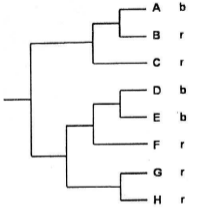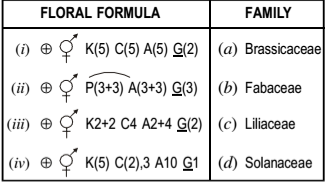 Multiple Choice Questions
Multiple Choice QuestionsWhich of the following groups represents SAR clade of protists?
Euglenozoans, Red algae, Parabasilids
Brown algae, Forams, Radiolarians
Slime moulds, Entamoebas, Diplomonads
Charophyes, Choanoflagellates, Tubulinids
Following table shows a list of clades and plant:
| Clades | Plant |
| (a) Basal angiosperms | (i) Black pepper |
| (b) Magnolids | (ii) Orchid |
| (c) Monocots | (iii) Star anise |
| (d) Eudicots | (iv) Strawberry |
Which one of the following is correct match for the above?
| (a) | (b) | (c) | (d) |
| (iii) | (iv) | (ii) | (i) |
| (a) | (b) | (c) | (d) |
| (i) | (i) | (iii) | (iv |
| (a) | (b) | (c) | (d) |
| (ii) | (iv) | (iii) | (i) |
| (a) | (b) | (c) | (d) |
| (iii) | (i) | (ii) | (iv) |
D.
| (a) | (b) | (c) | (d) |
| (iii) | (i) | (ii) | (iv) |
The basal angiosperms are the flowering plants which diverged from the lineage leading to Nymphaeales (water lilies, together with some other aquatic plants) and Austrobaileyales (woody aromatic plants including star anise). Eudicots includes—The rose family (Rosaceae) provides fruits such as strawberries, raspberries, apples, cherries, peaches, and plums and others. Orchids are the largest family of monocots among the angiosperms (flowering plants), with between twenty-five thousand and thirty thousand species, and new species are continually being described. Piperales, order of flowering plants comprising 3 families, 17 genera, and 4,170 species. Along with the orders Laurales, Magnoliales, and Canellales, Piperales forms the Magnoliid clade, which is an early evolutionary branch in the angiosperm tree; the clade corresponds to part of the subclass Magnoliidae under the old Cronquist botanical classification system.
The phylogenetics tree below shows evolutionary relationships among 8 species. Males of these species are either blue (b) or red (r) in color, the color being indicated next to each species name.

Based on the principle of parismony, which of the following statements best represents the evolution of male body color in this set or species?
The most recent common ancestor of all 8 species was blue; red evolved independently 5 times.
The most recent common ancestor of all 8 species was blue; red evolved independently 4 times.
The most recent common ancestor of all 8 species was red; blue evolved independently 3 times.
The most recent common ancestor of all 8 species was red; blue evolved independently 2 times.
A list of floral formulae and plant families are given in the following table:

Which of the following option most appropriately matches given plant families with their representative floral formulae?
(i)-d, (ii)-(b), (iii)-(a), (iv)-(c)
(i)-(d), (ii)-(c), (iii)-(a), (iv)-(b)
(i)-(d), (ii)-(c), (iii)-(b), (iv)-(a)
(i)-(a), (ii)-(c), (iii)-(b), (iv)-(d)
Which of the following plastid coding region(s) have been recommended as a core barcode by Plant Working Group of the consortium for the Barcode of Life?
CO1 and rbcL
rbcL and matK
CO1 and matK
rbcL only
